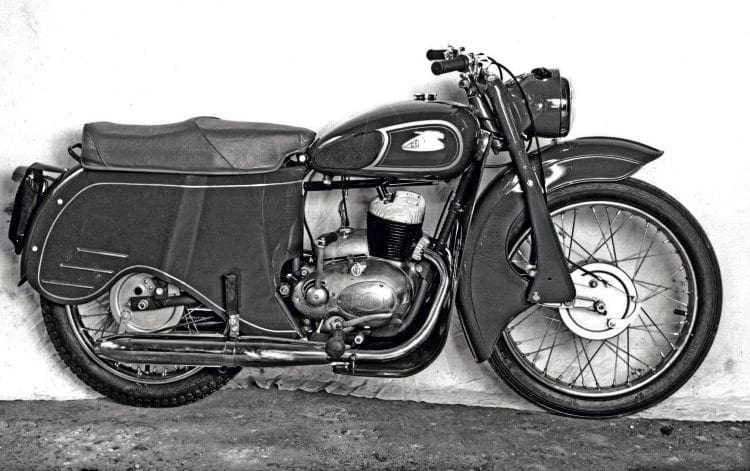Vale-Onslow barrel conversions
Before his prominence in the motorcycle industry, specifically with Norton Villiers Triumph (NVT), Mike Jackson successfully campaigned Greeves off road machines. He remembers the instant success of the Vale-Onslow (V-O) 250cc conversion kit, as featured in our August 2019 issue, page 88.
“From memory, the V-O 250cc barrel conversion, priced at £25, hit the market in the middle of the 1958 UK scrambles season. It was instantly popular because it was a straight ‘bolt on’ job which didn’t involve splitting the crankcases. The kit comprised a barrel, head and piston – I can’t remember if fasteners and gaskets were included. And its great appeal was its easy bolt-on factor to the Villiers engine bottom half and the ease of fit of the carburettor to barrel.
Enjoy more Classic MotorCycle reading in the monthly magazine.
Click here to subscribe & save.

“I must state that the 250cc motocross market wasn’t a hotbed of technology at the time – most competitors’ machines were 197cc Villiers 6E or 8E powered, pitted against clapped out pre Second World War 250cc four-strokes, with the odd Jawa or Maico recently imported from mainland Europe thrown in. For the most part, Villiers engines resided in Barnetts, Dots or Jameses, and out of several hundred competitors across the UK there were but a few quick ones, including the Sharp brothers, John Clayton, Brian Leask and the odd Dot works entry. The market was crying out for more power.
Read more in the October 2019 issue of TCM – on sale now!
Reading Standard
After you identified Hastings as the issuing authority for the mystery American machine for which I sent you a photograph (TCM, September 2019, page 88) I investigated the local licensing records for the area via the Kithead Trust and have discovered the machines was registered as a ‘Reading’ and therefore surmise it was a Reading Standard.
Chris Booth, The CM Booth Collection, Kent.
Thanks Chris. A solution which solves two mysteries; the make of machine and the logo RS my son-in-law Justin thought he could see on the fuel tank. And as you thought, Chris, the machine is American.

Although I’d considered Reading Standard as hand gear and clutch levers (clutch also worked by foot) on the left side of the tank along with the forks looked right, it had been dismissed, as the machine fuel tank usually bore the script Reading Standard with a small logo bearing RS preceding the word ‘Reading.’ Other than the logo RS spotted by Justin, none of the remaining script is visible in the photo.
Read more in the October 2019 issue of TCM – on sale now!
Crossed wires causing confusion
Two was or three years ago, I viewed a Cotton Messenger motorcycle on offer.
Expecting a scrambles machine, I was disappointed to see on arrival a roadster with Villiers 325cc engine.

After some prompting from my friend I bought it, but I still can’t get the idea that it should have been a scrambler out of my head.
Doug Grange, email.
The Cotton first. The Messenger is quite a rarity and one I’ve never seen.
Read more in the October 2019 issue of TCM – on sale now!
Triumph Model P
Can you please identify the model of Triumph motorcycle in this photograph? The lady posing on the machine is Don’s mother-in-law, then Eve Staples, a short time before she married Jim Pavitt in August 1928.
Don Fisher and Tom Coomber, email.
A stunning photo Don and Tom of one happy lady on a smart machine. It is a circa 1925 494cc side-valve Triumph Model P, bearing the-Essex registration mark issued in late 1925 or early 1926.

With cash continuing to tighten, in the mid 1920s makers were finding lots of ways to make cheaper motorcycles in an effort to keep the cash registers ringing. And even if profits were marginal, the optimists believed better times would soon return. Unfortunately, history confirms otherwise and many more motorcycle makers went under.
Read more in the October 2019 issue of TCM – on sale now!
Advert
 Enjoy more The Classic MotorCycle reading in the monthly magazine. Click here to subscribe.
Enjoy more The Classic MotorCycle reading in the monthly magazine. Click here to subscribe.



